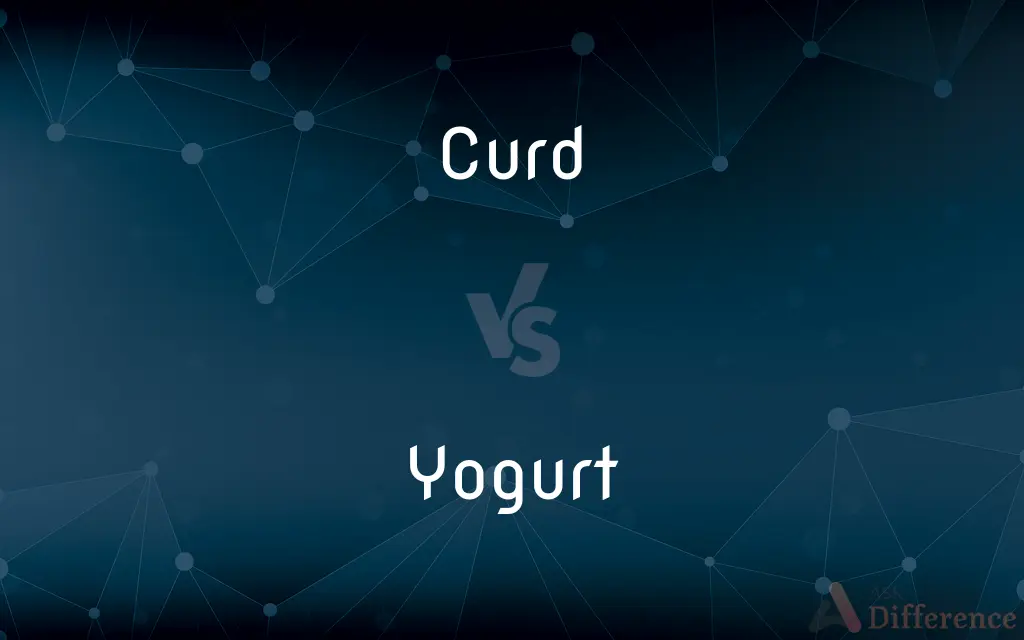Curd vs. Yogurt — What's the Difference?
By Urooj Arif & Maham Liaqat — Updated on March 11, 2024
Curd is formed by curdling milk with edible acidic substances, while yogurt is created through bacterial fermentation, specifically using Lactobacillus cultures.

Difference Between Curd and Yogurt
Table of Contents
ADVERTISEMENT
Key Differences
Curd is a dairy product obtained by coagulating milk in a process called curdling. This can be achieved by adding lemon juice, vinegar, or any other edible acidic substance to warm milk, which causes the milk proteins to coagulate, forming curd. Yogurt, on the other hand, is produced through the bacterial fermentation of milk, specifically using cultures of Lactobacillus delbrueckii subsp. bulgaricus and Streptococcus thermophilus. These bacteria ferment the lactose in milk, producing lactic acid, which acts on milk proteins to give yogurt its texture and tangy flavor.
The production process is a key difference between the two: curd-making involves the simple addition of an acidic substance to milk, while yogurt-making requires controlled fermentation using specific bacterial cultures. This results in distinct textures and flavors, with yogurt generally having a more uniform and creamy consistency compared to curd.
In terms of nutrition, both curd and yogurt are rich in calcium, protein, and essential vitamins, but the probiotics in yogurt can provide additional health benefits, such as improving digestion and boosting immunity. However, the nutritional content can vary based on factors like fat content and additional ingredients.
Curd is more commonly used in South Asian cuisine, where it is included in various dishes, both sweet and savory. Yogurt, with its distinct tangy flavor and smooth texture, is widely used in cuisines around the world, from Greek tzatziki to Indian raita, and can also be found in flavored and sweetened varieties.
Comparison Chart
Production Method
Curdling milk with edible acidic substances.
Fermenting milk with specific bacteria (Lactobacillus).
ADVERTISEMENT
Texture
Can vary; generally less smooth than yogurt.
Creamy and smooth.
Flavor
Depends on the milk and acid used; generally mild.
Tangy due to lactic acid produced during fermentation.
Probiotic Content
Lower; depends on the method of preparation.
Higher; contains live cultures that can offer health benefits.
Usage
Common in South Asian cuisine, used in various dishes.
Versatile, used globally in both savory and sweet dishes.
Compare with Definitions
Curd
Can vary in texture and taste based on preparation methods.
The curd turned out to be particularly creamy with the use of full-fat milk.
Yogurt
A dairy product produced by fermenting milk using specific bacterial cultures.
Greek yogurt is known for its thick consistency and high protein content.
Curd
A dairy product made by curdling milk with an acidic substance.
She made fresh curd at home using lemon juice to curdle the milk.
Yogurt
Characterized by its creamy texture and tangy flavor.
The tangy flavor of yogurt makes it a favorite base for smoothies.
Curd
A traditional component of many cuisines, often homemade.
Homemade curd is a staple in daily meals in many Indian households.
Yogurt
Used globally in a variety of culinary applications.
Yogurt is a key ingredient in the marinade for traditional tandoori dishes.
Curd
Rich in calcium and protein, but probiotic content varies.
Consuming curd regularly contributes to a healthy diet, offering essential nutrients.
Yogurt
Contains probiotics, beneficial for digestive health.
Eating yogurt with live cultures can help improve gut health.
Curd
Often used in cooking and as an accompaniment to meals.
Curd rice is a comforting dish popular in southern India.
Yogurt
Available in many varieties, including flavored and sweetened.
Strawberry yogurt is a popular choice for a quick, flavored snack.
Curd
Curd is obtained by coagulating milk in a sequential process called curdling. It can be a final dairy product or the first stage in cheesemaking.
Yogurt
Yogurt (UK: ; US: , from Turkish: yoğurt) also spelled yoghurt, yogourt or yoghourt, is a food produced by bacterial fermentation of milk. The bacteria used to make yogurt are known as yogurt cultures.
Curd
The part of milk that coagulates when the milk sours or is treated with enzymes. Curd is used to make cheese.
Yogurt
A semi-solid sourish food prepared from milk fermented by added bacteria, often sweetened and flavoured
Low-fat yogurt
Frozen yogurts
Curd
A lump of curd
Cheese curds.
Yogurt
A custardlike food with a tart flavor, prepared from milk curdled by bacteria, especially Lactobacillus bulgaricus and Streptococcus thermophilus, and often sweetened or flavored.
Curd
A coagulated liquid that resembles milk curd.
Yogurt
A milk-based product stiffened by a bacterium-aided curdling process, and sometimes mixed with fruit or other flavoring.
Curd
To form or cause to form into curd; curdle.
Yogurt
Any similar product based on other substances (e.g. soy yogurt).
Curd
The part of milk that coagulates when it sours or is treated with enzymes; used to make cottage cheese, dahi, etc.
Yogurt
A custard-like food made from curdled milk
Curd
The coagulated part of any liquid.
Curd
The edible flower head of certain brassicaceous plants.
Curd
(intransitive) To form curd; to curdle.
Curd
(transitive) To cause to coagulate or thicken; to cause to congeal; to curdle.
Curd
The coagulated or thickened part of milk, as distinguished from the whey, or watery part. It is eaten as food, especially when made into cheese.
Curds and cream, the flower of country fare.
Curd
The coagulated part of any liquid.
Curd
The edible flower head of certain brassicaceous plants, as the broccoli and cauliflower.
Broccoli should be cut while the curd, as the flowering mass is termed, is entire.
Cauliflowers should be cut for use while the head, or curd, is still close and compact.
Curd
To become coagulated or thickened; to separate into curds and whey
Curd
A coagulated liquid resembling milk curd;
Bean curd
Lemon curd
Curd
Coagulated milk; used to made cheese;
Little Miss Muffet sat on a tuffet eating some curds and whey
Common Curiosities
How do the textures of curd and yogurt differ?
Yogurt is generally smoother and creamier than curd, which can have a variable texture.
Is yogurt considered healthier than curd?
Both are nutritious, but yogurt's probiotics can offer additional digestive and immune benefits.
Can I use curd and yogurt interchangeably in recipes?
While they can sometimes be substituted, their distinct textures and flavors might affect the dish.
What is the primary difference in the production of curd and yogurt?
Curd is made by curdling milk with an acid, while yogurt is fermented with specific bacteria.
Is it common to make curd at home?
Yes, especially in South Asian cultures where curd is a daily staple.
Can curd contain probiotics?
Yes, but the probiotic content in curd is less consistent and depends on the preparation method.
Can the type of milk affect the end product of curd and yogurt?
Yes, the fat content and quality of milk can influence the texture and flavor.
Can flavored curd be made similar to flavored yogurt?
Yes, flavors can be added to curd, though it's less common than with yogurt.
Is yogurt more popular globally than curd?
Yes, yogurt is widely consumed around the world in various forms and flavors.
Is yogurt always made with cow's milk?
No, yogurt can also be made from other types of milk, like goat, sheep, or plant-based alternatives.
Are there different types of yogurt?
Yes, including Greek yogurt, set yogurt, and various flavored varieties.
Do curd and yogurt have the same nutritional value?
Their nutritional profiles are similar, but yogurt's probiotics can add health benefits.
Why is yogurt tangier than curd?
The specific bacteria used in yogurt produce more lactic acid, giving it a tangier flavor.
How long does it take to make curd compared to yogurt?
Curd can set in a few hours, while yogurt fermentation takes longer, often overnight.
How do probiotics in yogurt benefit health?
They can improve gut health, enhance digestion, and support the immune system.
Share Your Discovery

Previous Comparison
England vs. Wales
Next Comparison
Ophthalmology vs. OtolaryngologyAuthor Spotlight
Written by
Urooj ArifUrooj is a skilled content writer at Ask Difference, known for her exceptional ability to simplify complex topics into engaging and informative content. With a passion for research and a flair for clear, concise writing, she consistently delivers articles that resonate with our diverse audience.
Co-written by
Maham Liaqat














































